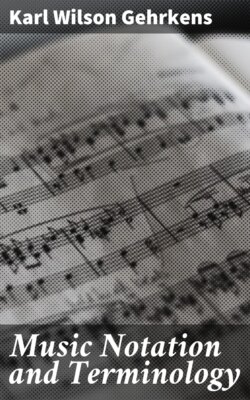Читать книгу Music Notation and Terminology - Karl Wilson Gehrkens - Страница 7
На сайте Литреса книга снята с продажи.
Symbols of Music Defined
ОглавлениеTable of Contents
12. A staff is a collection of parallel lines, together with the spaces belonging to them. The modern staff has five lines and six spaces, these being ordinarily referred to as first line, second line, third line, fourth line, and fifth line (beginning with the lowest); and space below (i.e., space below the first line), first space, second space, third space, fourth space, and space above.
The definition and discussion above refer more specifically to one of the portions of the "great staff," the latter term being often applied to the combination of treble and bass staffs (with one leger line between) so commonly used in piano music, etc.
13. The extent of the staff may be increased either above or below by the addition of short lines called leger lines,[4] and notes may be written on either these lines or on the spaces above and below them.
14. The lines and spaces constituting the staff (including leger lines if any) are often referred to as staff degrees, i.e., each separate line and space is considered to be "a degree of the staff." The tones of a scale are also sometimes referred to as "degrees of the scale."
15. A clef[5] is a sign placed on the staff to designate what pitches are to be represented by its lines and spaces. Thus, e.g., the G clef shows us not only that the second line of the staff represents G, but that the first line represents E, the first space F, etc. The F clef similarly shows us that the fifth line of the bass staff represents the first A below middle C, the fourth line the first F below middle C, etc.
The student should note that these clefs are merely modified forms of the letters G and F, which (among others) were used to designate the pitches represented by certain lines when staff notation was first inaugurated. For a fuller discussion of this matter see Appendix A, p. 101.
16. When the G clef is used the staff is usually referred to as the treble staff, and when the F clef is used, as the bass staff. Such expressions as "singing from the treble clef," or "singing in the treble clef," and "singing in the bass clef" are still frequently heard, but are preferably replaced by "singing from the treble staff," and "singing from the bass staff." Fig. 6 shows the permanent names of lines and spaces when the G and F clefs are used.[6]
17. The movable C clef or , formerly in very common use, is now utilized for only two purposes, viz., (1) in music written for certain orchestral instruments (cello, viola, etc.) of extended range, in order to avoid having to use too many leger lines; and (2) for indicating the tenor part in vocal music. This latter usage seems also to be disappearing however, and the tenor part is commonly written on the treble staff, it being understood that the tones are to be sung an octave lower than the notes would indicate.
The C clef as used in its various positions is shown in Figs. 7, 8, and 9. It will be noted that in each case the line on which the clef is placed represents "middle C."
18. A sharp is a character which causes the degree of the staff with which it is associated to represent a pitch one half-step higher than it otherwise would.
Thus in Fig. 10 (a) the fifth line and first space represent the pitch F, but in Fig. 10 (b) these same staff degrees represent an entirely different tone—F♯. The student should note that the sharp does not then raise anything; it merely causes a staff degree to represent a higher tone than it otherwise would. There is just as much difference between F and F♯ as between B and C, and yet one would never think of referring to C as "B raised"!
19. A flat is a character that causes the degree of the staff with which it is associated to represent a tone one half-step lower than it otherwise would. (See note under Sec. 18 and apply the same discussion here.)
20. A double-sharp causes the staff degree on which it is placed to represent a pitch one whole-step higher than it would without any sharp. Similarly, a double-flat causes the staff degree on which it is placed to represent a pitch one whole-step lower than it would without any flat.
Double-sharps and double-flats are generally used on staff degrees that have already been sharped or flatted, therefore their practical effect is to cause staff degrees to represent pitches respectively a half-step higher and a half-step lower than would be represented by those same degrees in their diatonic condition. Thus in Fig. 10 (b) the first space in its diatonic condition[7] represents F-sharp, and the double-sharp on this degree would cause it to represent a pitch one-half step higher than F-sharp, i.e., F-double-sharp.
